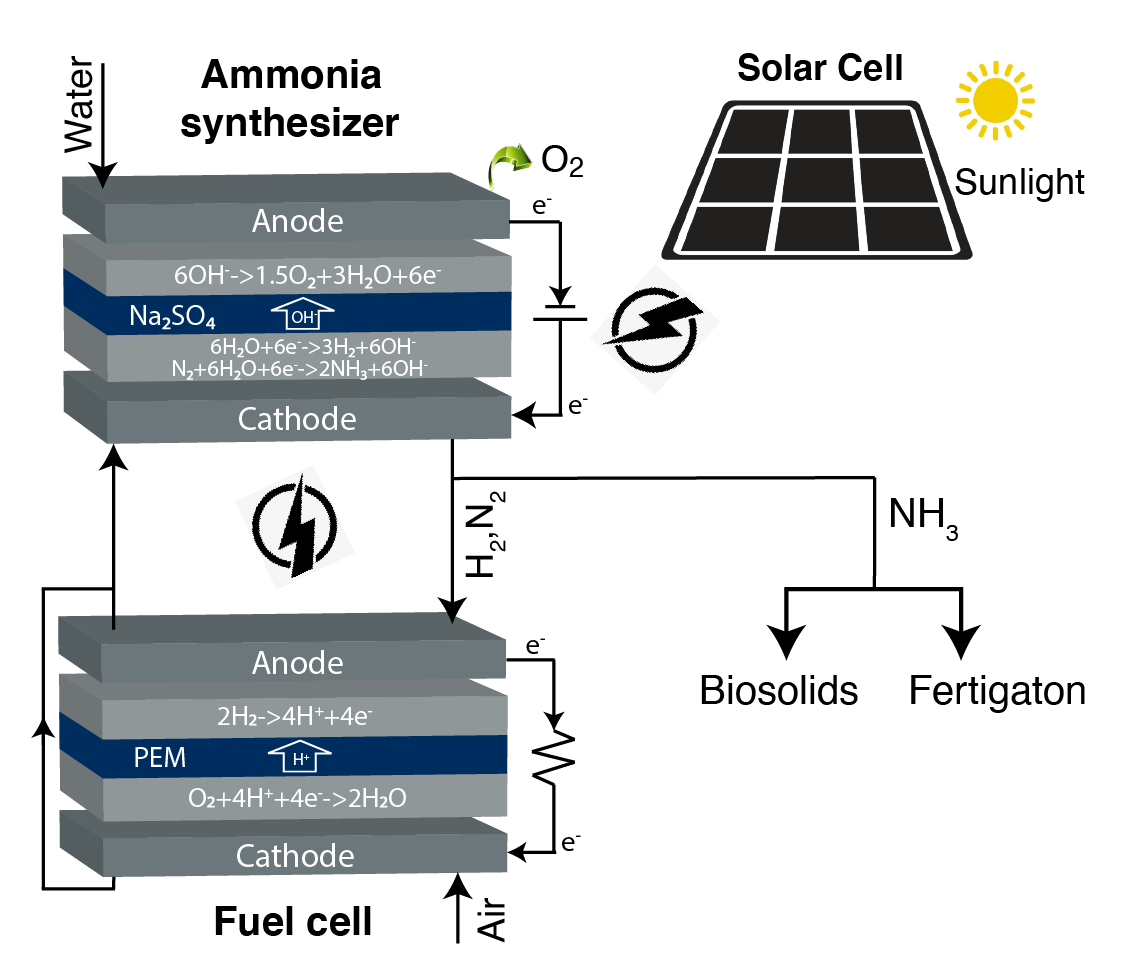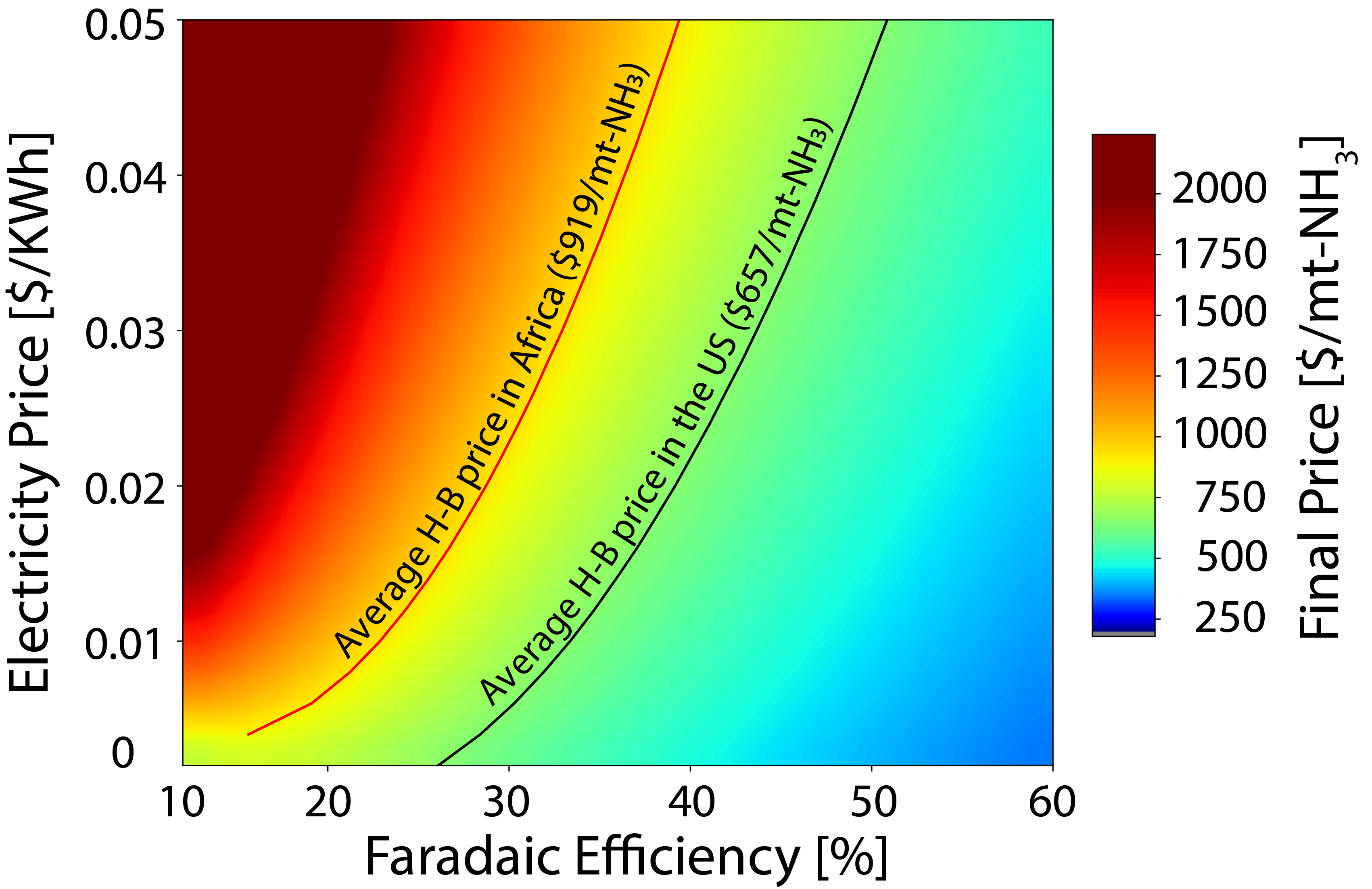Ammonia has an annual global production of more than 170 million metric tons, 85% of which are further processed to Nitrogen based fertilizers (Pattabathula and Richardson 2016). N fertilizers are estimated to feed half of the global population (Zhang et al. 2015). Thus, ammonia plays a key role in feeding the sustaining growing human population and helps solve the world hunger issue. In the early 1900s, Haber and Bosch invented a thermocatalytic process to synthesize ammonia from nitrogen and hydrogen, which is well known as the Haber-Bosch process right now, and it is currently the only industrialized process to produce... read more
Prospective and Economic Analysis for solar fertilizers
Ammonia has an annual global production of more than 170 million metric tons, 85% of which are further processed to Nitrogen based fertilizers (Pattabathula and Richardson 2016). N fertilizers are estimated to feed half of the global population (Zhang et al. 2015). Thus, ammonia plays a key role in feeding the sustaining growing human population and helps solve the world hunger issue. In the early 1900s, Haber and Bosch invented a thermocatalytic process to synthesize ammonia from nitrogen and hydrogen, which is well known as the Haber-Bosch process right now, and it is currently the only industrialized process to produce ammonia. However, there are downsides of the process, firstly, the extreme reaction conditions, including higher temperature (700K) and pressure (100 bar), limit the production process in a centralized form from the economic view. Moreover, hydrogen is used as the feedstock for the production of ammonia, most of which (80%) is derived from the methane reforming process by using natural gas (Wang et al. 2018). Consequently, the H-B is carried out to be carbon intensive with approximately 2 tons of CO2 accompanying the production of each ton of NH3. For these reasons, the H-B process accounts for approximately 2% of the global energy consumption and 1.2% of the global emission of greenhouse gas (Appl 2000).
But with more than 100 years of development, the centralized plant is energy efficient with a thermochemical efficiency of up to 70%, and the cost of the production keeps decreasing. Nonetheless, the huge capacity of the plant requires a large amount of natural gas feedstock and a stable society environment to operate, which leads to the dense location of H-B plants in some developed and Asian countries (McArthur and McCord 2017). However, the demand of N based fertilizers is dispersed globally since the distribution of cropland and pasture worldwide is not concentrated. When the large scale ammonia production plant can not be conducted in some area, the need of N based fertilizers can only be met through long range or oversea transportation from the dense production locations to the fertilizer demanding locations and a unified storage place. The poor accessibility of fertilizers affect more obviously on some remote areas such as sub-Saharan Africa, where the average nitrogen fertilizer usage per hectare of cropland is inadequate to maintain soil fertility, leading to the crop yields not increasing substantially. As a result, a share of 10% to more than 60% of the total population in sub-Saharan is undernourished (https://ourworldindata.org/). Things become even worse when this severe circumstance won’t have much improvement in next decades since the H-B process plant remains unaffordable for remote countries and there is always a need for oversea transportation and storage. At the same time, for areas where fertilizers are easily available and then over fertilization more often becomes a problem. When the high concentrated fertilizers are applied during agricultural practices, nitrogen may runoff from farms and could contaminate the cropland surface and underground water, which will further pollute the ocean to form “dead zones” in coastal areas, such as the Gulf of Mexico (Diaz and Rosenberg 2008). Moreover, the gas emission of nitrous oxide from the ammonia based fertilizers accounts for another part of the greenhouse gas issue.
With the consideration of the high energy consumption and carbon footprint of the centralized ammonia production plant, one strategy is possible to overcome the challenges, which is by integrating renewable energies and a carbon free ammonia production process in a decentralized small-scale facility. Renewable energies are becoming increasingly abundant and more efficient energy sources for industrial practices with much lower environmental effect compared to fossil fuels. Solar energy here can integrate perfectly with agricultural applications since crops are usually growing in areas with adequate solar irradiation from the sun, which promise enough energy can be captured to provide the whole process. Meanwhile, huge effort has been devoted into the development of the carbon free ammonia production process, especially the electrochemical ammonia synthesis process. Electrochemical reduction from N2 to ammonia is an attractive approach for ammonia production since the reaction is usually conducted under mild conditions while using inexpensive N2 and H2O as feedstocks, which are also accessible to farms. The other aspect considered here is to conduct the nitrogen fixation process ultimately in a small on-site scale, and the product can be directly utilized at the point of production, which avoids the transportation and storage of fertilizers from centralized plants to farms.
Although the on-site electrochemical ammonia production shows substantial advantages than the traditional H-B process, there are still considerable challenges. One critical issue of this nitrogen fixation process is to break the stable triple bond between nitrogen atoms at ambient conditions. When operated by solar electricity, the electrochemical conversion of nitrogen and selectivity towards ammonia is far from realistic applications. On the other hand, there is a need to consider the concentration difference between the traditional fertilizers and the product from the on-site ammonia production process. The well developed H-B process can produce fertilizers in very high efficiency and increase the nitrogen concentration in the fertilizer to reduce the transportation and storage fee, however, the electrochemical NH3 production can only be expected to have a dilute nitrogen concentration with the limitation of the catalysts. As a result, how to efficiently utilize this low fixed nitrogen concentration to the agricultural practices becomes another aspect of the challenges.
In this project, we demonstrate the viability of practical application of the electrochemical nitrogen reduction to ammonia in a small on-site scale. The whole application system has been divided into 4 sub-systems: solar cells, a PEM fuel cell, an ammonia synthesizer, and a NH3 agricultural application system. The advantages and challenges of each sub-system are discussed and possible strategies to improve the efficiency are given. Moreover, we develop an economic analysis model to evaluate the system, and provide the estimate of the performance targets of electrocatalysts to beat the traditional H-B process.
Energy system

The whole system can be divided into 4 sub-systems:
- Solar cell
The solar cell convert the energy from the sunlight to electronic energy to drive the whole system.
- PEM fuel cell
PEM fuel cell has two functions: clean up the air to remove the oxygen; utilize the side product hydrogen generated from the ammonia synthesizer.
- Ammonia synthesizer
The reactor that utilizes N2 and water to produce ammonia with electricity as the power.
- Ammonia application
Ammonia can be applied to the agriculture by different ways: Biosolids and Fertigation.
Module system
The ammonia producing system is a module system, which can be connected with each other to save the cost.

Breakeven

The market price per ton of ammonia for the current state-of-the-art Haber-Bosch process is stable at around $600, while the price to produce one ton of ammonia by the complex system varied with the performance of the catalytic reaction. To achieve a breakeven price, the required faradaic efficiency (FE) for the nitrogen electro-reduction to ammonia catalytic reaction is around 42%, which is still much higher than the current FE (10% ~ 20%) for good performance catalysts.
Price Map

The price contour map shows the market price of ammonia produced by the complex system as a function of the electricity price and the faradaic efficiency. The two curves represent the average H-B ammonia price in Africa and USA, respectively. The complex system has a lower price when going further right from the curve.
Conclusion
-
The module ammonia producing system can utilize the electric energy and simple sources to produce value added product ammonia in a small scale, which can be applied in some undeveloped areas where the centralized H-B process is hard to be commercialized.
-
The current performance of catalysts cannot achieve the requirement of the facility, so further developments are needed.


Comments